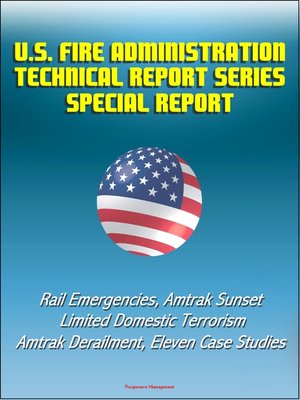U.S. Fire Administration Technical Report Series Special Report
ebook ∣ Rail Emergencies, Amtrak Sunset Limited Domestic Terrorism, Amtrak Derailment, Eleven Case Studies
By Progressive Management

Sign up to save your library
With an OverDrive account, you can save your favorite libraries for at-a-glance information about availability. Find out more about OverDrive accounts.
Find this title in Libby, the library reading app by OverDrive.



Search for a digital library with this title
Title found at these libraries:
| Loading... |
The USFA has selected the topic of rail emergencies as the subject of a special report under the Major Fires Investigation Program. The focus of this report will be the planning and response aspects of managing large scale rail emergencies from the standpoint of command and control, with the objective of providing care to the injured.The purpose of this Special Report is to identify the challenges to strategic planning and tactical operations in the area of rail transportation emergencies and to provide planning suggestions for fire and rescue departments. While this report addresses operations at all types of rail systems; (inter state, inter city, urban commuter, and both privately and publicly operated), the focus is mainly on the emergency response issues pertaining to passenger rail emergencies and the rescue and patient care missions. Hazardous materials are addressed only as a component of response planning. Significant incidents over a 12-year period are reviewed and discussed. The report can serve as a planning resource document for the development of training scenarios, or can be reviewed as basic background research.USFA wants to share the "lessons learned" from this incidents with the fire service. In the case of rail emergencies, this is especially pertinent because few organizations have direct experience with large-scale rail emergencies. Yet few departments can dismiss the possibility that they may be called upon to respond to this very type of disaster.Contents: INTRODUCTION * SUMMARY OF KEY ISSUES * SCOPE OF PROBLEM * COMMAND AND CONTROL * Command Post Operations/Locations * TACTICAL CONSIDERATIONS * Accountability of Victims * Logistical Support * Convergence * Media Considerations * Access/Mobility * Physical Hazards * Extrication * Environmental Factors * Search and Rescue * Suppression Operations * Hazardous Materials * CASUALTY MANAGEMENT * Access/Egress * Types of Injuries * Triage * Treatment * Disposition * Transport * Incident Communications * Radios * Channels * PLANNING CONSIDERATIONS * Pre-Plan/Drills * Locations of track; right-of-way, operators * Access points/landmarks, mileposts, and maps * Electric cut-offs, controls * Access to specialized resources * Unified Command System * CASE STUDIES * CONCLUSION






